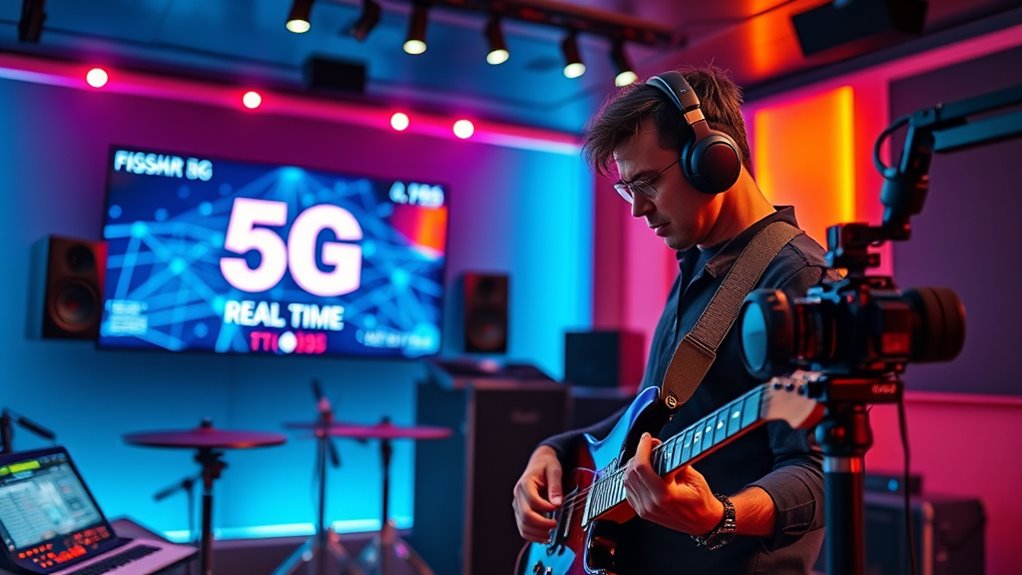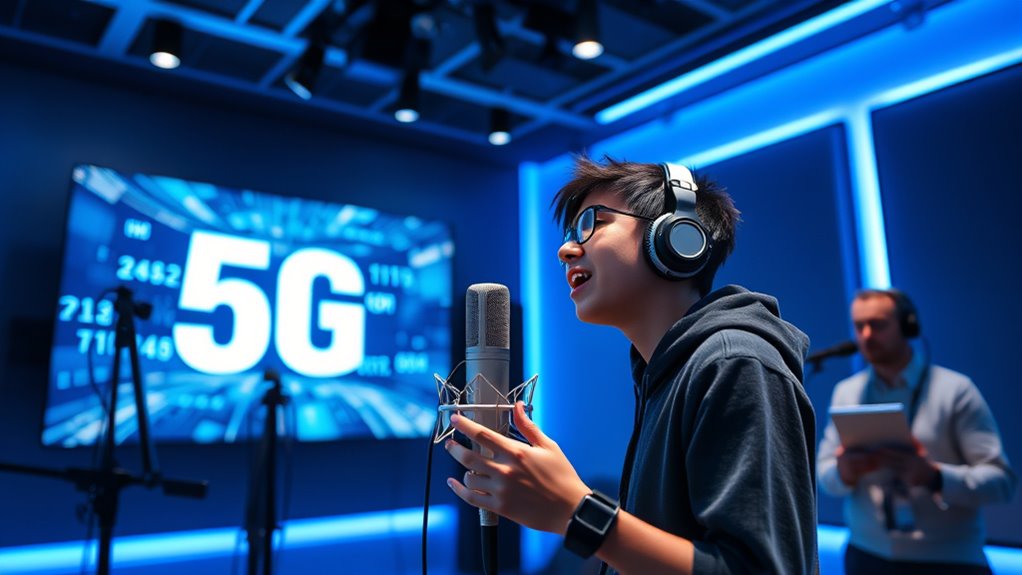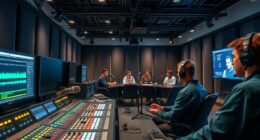5G remote recording sessions offer you faster, more reliable connections, making collaboration feel almost in-person. You’ll benefit from minimal lag, instant playback, and high-quality audio streaming that enhances creativity and spontaneous ideas. However, technical issues can still happen, so having backup plans is wise. Understanding how to optimize your setup ensures smooth sessions. Want to discover more about maximizing 5G’s advantages and avoiding common pitfalls? Keep exploring to get the full picture.
Key Takeaways
- 5G enables low-latency, high-quality audio streaming, enhancing real-time collaboration during remote recording sessions.
- It allows simultaneous multi-take recording with instant playback, maintaining spontaneity similar to in-person sessions.
- Technical issues like connectivity drops or hardware limitations can still disrupt sessions, requiring backup plans.
- Proper equipment setup and network optimization are essential to fully benefit from 5G’s capabilities.
- Understanding workflow and tool familiarity helps mitigate challenges and ensures smooth remote recording experiences.

As 5G technology becomes more widespread, remote recording sessions are transforming how musicians and producers collaborate. With faster internet speeds and reduced latency, you can now work seamlessly with artists and engineers from different locations, making the process more efficient and flexible. To fully leverage these benefits, your equipment setup plays a pivotal role. You’ll want high-quality microphones, audio interfaces, and reliable computers that can handle real-time data transfer without glitches. A stable, high-speed internet connection is indispensable, and 5G provides that by minimizing lag and buffering issues. Setting up your workspace with proper acoustic treatment and noise isolation ensures clean recordings, even when working remotely. You should also invest in good headphones and monitors to accurately hear all details during the session. Proper network configuration can further optimize your connection and reduce disruptions during live sessions. Communication strategies are key to making remote recording sessions successful. Since you’re collaborating over a distance, clear and consistent communication is essential. Use dedicated platforms like Zoom, Skype, or specialized DAW collaboration tools that support real-time audio sharing. Before each session, establish clear plans: share project files, session goals, and timelines in advance. During the session, keep a steady dialogue to troubleshoot technical issues and make creative decisions quickly. Using visual cues, screen sharing, or video feeds can help you coordinate more effectively. You might also consider creating a shared workspace or cloud storage for all project assets so everyone has access to the latest files without delays. The combination of a solid equipment setup and well-planned communication strategies allows you to maximize the advantages of 5G in remote recording. With low latency, you can record multiple takes simultaneously, listen to playback instantly, and make adjustments on the fly. This real-time interaction helps maintain the spontaneity and energy of in-person sessions, even if you’re miles apart. However, keep in mind that technical issues can still arise, so having backup plans in place, like local recordings or alternative internet connections, is prudent. Ensuring everyone understands the workflow and tools involved minimizes misunderstandings and keeps the session flowing smoothly.
Frequently Asked Questions
How Secure Is Remote Recording Data Transmission?
Remote recording data transmission is generally secure when you use data encryption to protect your files. However, bandwidth requirements play a role; a stable, fast connection minimizes risks of data breaches or interruptions. To guarantee safety, always choose secure, encrypted platforms and verify your internet speed. By doing so, you keep your recording data safe during transmission and avoid potential security issues.
What Equipment Is Essential for Remote Recording Sessions?
Ever wondered what it takes to get studio-quality sound from home? You’ll need a good microphone selection suited to your recording needs, along with proper attention to room acoustics to minimize echoes and background noise. A quality audio interface, headphones, and a stable internet connection are essential. Do you have the right space and gear to guarantee your recordings sound professional? With these essentials, you can create high-caliber remote sessions.
How Do Remote Sessions Affect Audio Quality?
Remote sessions can impact your audio quality by introducing latency issues, which may cause timing discrepancies, and by emphasizing the importance of good studio acoustics. Poor acoustics can lead to unwanted echoes or background noise, reducing clarity. To guarantee high-quality recordings, you need fast, stable internet, and a well-treated space. Proper setup and monitoring help you catch and fix issues early, maintaining professional sound even remotely.
Can Remote Recording Sessions Replace In-Studio Work Entirely?
Remote recording sessions can potentially replace in-studio work, as 60% of artists now prefer remote collaboration for convenience. While they offer increased studio accessibility and flexibility, they might not fully replicate the acoustic environment or real-time interaction of in-studio sessions. However, with advances in technology, remote recordings are becoming more viable, making it a practical option for many artists, though some still favor the traditional studio experience.
What Licensing Considerations Are Unique to Remote Recordings?
When handling remote recordings, you need to consider licensing agreements and copyright issues carefully. You’re responsible for ensuring all participants have proper licenses to use any sampled or copyrighted material. Make sure to clarify rights in your licensing agreements to avoid legal issues later. Additionally, keep thorough records of permissions and licenses, as remote settings can complicate proof of legal use, protecting both parties from potential copyright disputes.
Conclusion
Embracing 5G remote recording sessions can transform how you create content, offering faster data transfer and seamless collaboration. Did you know that 85% of industry professionals believe 5G will considerably boost remote production quality? By leveraging this technology, you’ll experience fewer delays, improved audio and video quality, and greater creative freedom. As 5G continues to evolve, staying ahead means embracing these benefits now—empowering you to produce exceptional content anytime, anywhere.









